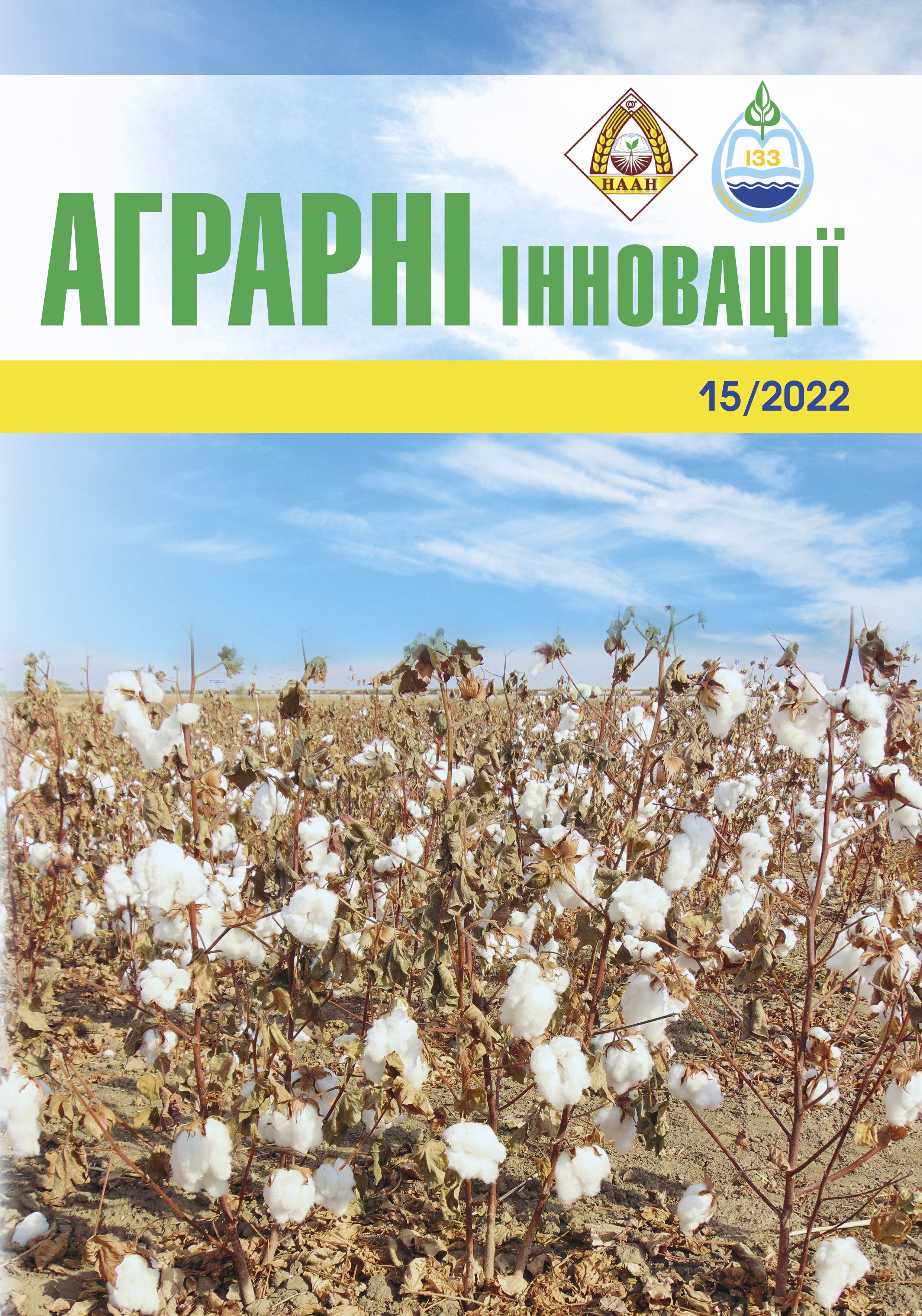MANIFESTATION AND VARIABILITY OF THE TRAIT “NUMBER OF BEANS ON THE PRODUCTIVE NODES OF THE PLANT” IN HYBRIDS AND SOYBEAN VARIETIES OF DIFFERENT MATURITY GROUPS
Abstract
The purpose determining the manifestation of the trait “number of beans on productive nodes of plants”in soybean varieties, parental components and hybrids, establishing the level of variability in hybrid combinations F1–F4 and determining the effectiveness of selections for productivity based on the indicator “number of beans on productive nodes of plants” from hybrid populations F2– F5. Methods. Field experiment, methods of mathematical statistics. Results. The maximum values of the number of beans on the nodes of the plant were noted in varieties of the early and mid-ripening group in 2008 – 5.20 and 4.70 pieces, respectively. In 2009, soybean varieties were somewhat inferior in terms of symptom manifestation. The group of late-ripening varieties had the highest indicators – 4.50 in 2008. The mid-ripening and late-ripening group of varieties was significantly inferior in terms of this feature in the dry year of 2007, which was a consequence of the impossibility of realizing the genetic potential of the varieties. An important informative indicator of selection efficiency is the coefficient of variation in the splitting generations (F2–F4). In our studies, trait variation in the first generation had low values (8.7–14.3%) and sharply increased in subsequent generations to 23–24% (Table 2). Particularly promising in terms of genotypic variability are the combinations involving height-contrasting parental forms – Kyivska 91/Apollon, USKHI-6/Vityaz50, Evans/ Apollon, in which the trait variation in the second to fourth generations exceeded 20%. This implies high genotypic diversity in these populations and effective selection. It is characteristic that the highest variability was recorded in F3. This may be a consequence of insufficient homozygosity in the second generation, possible subconscious selection of a certain morphotype in the process of reseeding, and the effect of natural selection in the direction of soybean genotypes that are most adapted to agro-ecological conditions and have a high reproduction ratio. The results of the analysis of the lines studied in the nursery of the preliminary variety test show that the following combinations of hybrid crossings turned out to be the most successful: Diona/Phaeton, Yug 30/Phaeton, Kyivska 91/Apollon, Yug 40/Apollon, USKHI-6/Phaeton, Evans/Apollon. These combinations were created with the participation of parental components contrasting in origin and duration of the vegetation period. Selections from these hybrid populations showed a high efficiency of selection for productivity according to the factorial indicator “the number of beans on the productive nodes of plants” had the highest weighted percentage of the output of elite families. Conclusions. It was established that in soybean, the trait “number of beans on productive nodes of plants” has significant genotypic variability and significant differences in varieties of different maturity groups, which can allow predicting the effectiveness of selection based on this factorial trait. Positive correlations of productivity and duration of the vegetation period were established, which indicates the need to carry out selections for productivity in separate maturity groups. In order to create new high-yielding soybean varieties under irrigation conditions with a yield of 3.5–5.5 t/ha, it is promising to use variety samples contrasting in maturity groups and genetic pedigree in crossings.
References
2. Білявська Л. Г., Білявський Ю. В., Шаповал О. С., Панченко С. С. Сучасний стан та перспективи насінництва сої в Лісостепу України. Вісник Полтавської державної аграрної академії. 2020. № 4. С. 45–52. https://doi.org/10.31210/visnyk2020.04.05.
3. Кириченко В. В., Рябуха С. С., Кобизєва Л. Н., Посилаєва О. О., Чернишенко П. В. Соя (Glycine max (L.) Merr.) : монографія. Харків : Інститут рослинництва ім. В.Я. Юр’єва НААН, 2016. 400 с.
4. Vozhehova R. A., Lavrynenko Y. O., Kokovikhin S. V., Lykhovyd P. V., Biliaeva I. M., Drobitko A. V., Nesterchuk V. V. Assessment of the CROPWAT 8.0 software reliability for evapotranspiration and crop water requirements calculations. Journal of Water and Land Development. Polish Academy of Sciences (PAN) in Warsaw. 2018. No. 39 (X–XII). P. 147–152. DOI: 10.2478/jwld-2018-0070 http://www.itp.edu.pl/ wydawnictwo/journal
5. Мельник А. В., Романько Ю. О., Романько А. Ю. Адаптивний потенціал і стресостійкість сучасних сортів сої. Таврійський науковий вісник. 2020. № 113. С. 85–91.
6. Кучеренко Є. Ю. Колекційні зразки сої як джерела високої продуктивності для селекції. Генетичні ресурси рослин. Харків: Інститут рослинництва ім. В. Я. Юр’єва, 2017. № 20. С. 55–62.
7. Agashe Nehatai Wamanrao, Vinod Kumar and Dronkumar Meshram. Correlation and Path Coefficient Analysis of Grain Yield and its Growth Components in Soybean (Glycine max. L.). Int. J. Curr. Microbiol. App. Sci. 2020. Vol. 9(3). P. 2445-2451. doi: https://doi. org/10.20546/ijcmas.2020.903.280
8. Ушкаренко В. О., Вожегова Р. А., Голобородько С. П., Коковіхін С. В. Методика польового досліду (зрошуване землеробство). Херсон : Грінь Д.С., 2014. 448 с.






